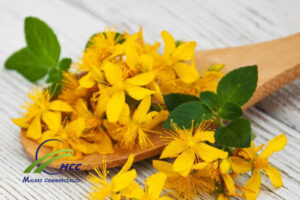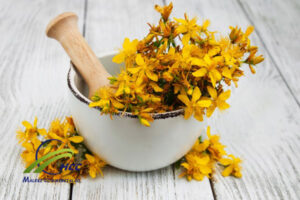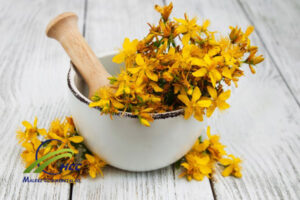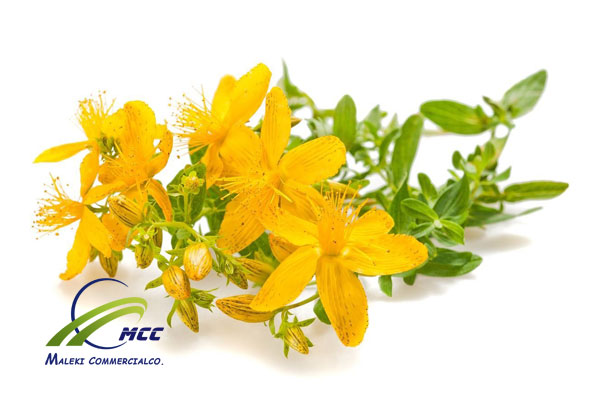All Information about Cultivation of Perforate St John’s-Wort
What is Perforate St John’s-Wort?
exports St John’s-Wort flower: Perforate St John’s-wort is a plant with the scientific name of Hypericum Perforatum L in the Hypericaceae family and plays an important role in foreign exchange earnings worldwide through annual export and import of large amounts of the plant to different countries.
Specifications of Perforate St John’s-Wort
Perforate St John’s wort is a herbaceous perennial plant. Stems are 10-11 cm long, the leaves are 5-35 mm long and 2-14 mm wide, and the petals are 5-35 mm long, covered with black spots. The sepals are lanceolate with acute tips, oblong or elliptical, covered with black spots on the upper surface. The flowers are white or yellow and aromatic, with a smell like spruce gum. Fruits are 6-10 mm long and brown in color.
There are clear dots on the leaves that look like pin holes, which is why this plant is called perforatum.
 Medicinal Part
Medicinal Part
Flower Stalk
Geographical Distribution
The temperate regions of Europe, Asia, Iran, America, Australia, and South Africa
Distribution in Iran
Gilan, Gorgan, Mazandaran, Kermanshah, Kurdistan, Ilam, Hamedan, Kohgiluyeh and Boyer-Ahmad, Khorasan, Semnan, Tehran, Fars, and East and West Azerbaijan
Worldwide Beliefs about Hypericum Perforatum
This plant commonly flowers and blossoms on the 24th of June around St John’s Feast Day, which is why it is called St John’s wort.
According to an ancient custom, the people of England put the plant into the fire on St. John’s Day.
Paracelsus used the plant in the 15th century to counteract magic.
Some ancient scholars believed that people with any religious beliefs would be able to dream the saint of their religion and live longer by placing this plant under their pillows.
Ecology of St John’s Wort Cultivation
This plant grows in most parts of the world and can be cultivated in different climatic conditions.
Lower altitudes lead to higher amounts of flavonoids in the plant.
The soil suitable for the growth of this plant should have the right amount of humus compounds. The plant absorbs cadmium from the soil and stores it.
St John’s wort is cold-resistant, and the suitable soil pH for its growth is 6-7.
This plant species lasts in the same soil for 4-5 years.
Crop rotation of St John’s wort is carried out after 4-5 years with alternative cultivation of grains or other clean-tilled crops.
 The required Fertilizers
The required Fertilizers
- Phosphorus oxide
- Potassium oxide
- Phosphorus
Propagation Methods
- Indirect planting
- Direct seeding
- Vegetative reproduction
-
Propagation by Indirect Planting
Direct seeding is not usually recommended because of the slow growth of the seeds at first.
The seeds are sown in a nursery under plastic in late winter (February). Sowing in the open-air nurseries takes place in March. The selection of sowing seeds under plastic or in the open air depends on climatic conditions.
For each square meter, 60-80 grams of seeds with high viability will be required.
After sowing and proper irrigation, the seedlings can be transplanted to the main soil in late May.
About 35-43 thousand seedlings are produced from every 100 m2 of nursery area.
-
Propagation by Direct Seeding
The seeds of the St John’s wort have a very slow initial growth, and there is a high probability of weed growth; therefore, direct seeding of this plant is not recommended.
Propagation of St John’s wort by the direct method is suitable for smaller lands with soil rich in humus and sufficient moisture.
Suitable rolling is required after sowing.
In this method, each hectare needs 2-5 kg of seeds with high viability.
-
Vegetative Reproduction
This method uses root divisions.
The 2-4-year-old healthy plants with no fungal infection are removed from the soil, and each plant is divided into 4-6 parts.
Each part should have at least one vegetative bud. Then, the root pieces are placed in the soil with the root cap at a depth of 2-5 cm.
Harvest Time
Harvest time depends on and varies from climate to climate.
The best time to harvest the flower stalk is early June to early July according to the region.
At this time, the flower stalks are cut and dried in such a way that the flowers do not separate from the stalk.
Drying Method
The best method is drying in the shade. If the plant harvest is high, drying in electronic dryers at a temperature of 40 °C is recommended.
Research has shown that drying the plant in the sun reduces hypericin by 80%.
 Therapeutic – Medicinal Properties of St John’s wort
Therapeutic – Medicinal Properties of St John’s wort
- Orexigenic effects
- Anti-viral
- Anti-inflammatory
- Antimalarial
- Anti-infective
- Antipyretic
- Emmenagogue
- Treatment of diarrhea
- Diuretic
- Tonic for the liver
- Treatment of insomnia
- Treatment of stress
- Treatment of depression
- Treatment of cystitis
- Treatment of peptic ulcer disease
- Healing burns
- Treatment of nerve entrapment
- Treatment of neuralgia
- Treatment of pediatrics infectious disease
- Treatment of indigestion caused by gastrointestinal diseases
- Treatment of lung diseases (asthma and bronchitis)
Note: Please consult your doctor before using this plant for treatment.
Supplier St John’s-Wort in Iran
Maleki commercial Group exports the best quality St John’s-Wort according to the needs of the customers in the form of EXW, FCA, CPT, CIP, DAT, DAP, FOB, FAC, CFR, and CIF.
Maleki commercial Group, the Largest Exporter of St John’s-Wort
Maleki commercial Group is the largest direct exporter of St John’s-Wort flower in Iran and Asia. Maleki commercial Group exports the best quality St John’s-Wort according to the needs of the customers in the form of EXW, FCA, CPT, CIP, DAT, DAP, FOB, FAC, CFR, and CIF.
For bulk purchase, can contact our consulting department.
Global Exports of St John’s-Wort
Maleki commercial Group is the global exporter of St John’s-Wort Flower with the most active compounds along with the best quality and price among all companies exporting this plant. This holding has achieved considerable success in exporting this plant to various countries without intermediaries.
If you need this high-quality export plant, you can confidently obtain the best quality from Maleki commercial Group with safe and standard packaging.
The Price of St John’s-Wort in Iran
Maleki commercial Group exports St John’s-Wort flower to Europe, Asia, and America under the brand of Elisso Sky, and has attracted customer satisfaction worldwide.
